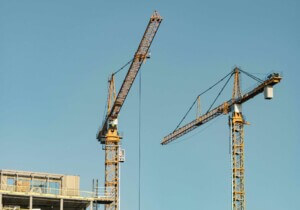A mid-year update to the American Institute of Architects’ (AIA) Consensus Construction Forecast has found that spending on nonresidential building projects is on the decline and will remain so through 2021. The AIA Consensus Construction Forecasting Panel estimated an overall dip of roughly 8 percent in spending in 2020 and just under 5 percent next year.
Per the AIA, this is the first time in nearly a decade that nonresidential construction spending has trended downwards. The reason for the decline is straightforward: investments in projects have waned due to economic disruptions prompted by a continuing global health crisis. And looking into 2021, forecasters believe that businesses and organizations wounded by the coronavirus pandemic will remain reluctant to invest in the construction of new facilities or the modernization of existing ones.
It’s worth noting that any optimism about the health of the U.S. economy that was present in May and June, when the spiking unemployment rate began to ease back down, largely flattened in mid-June as the COVID-19 crisis spread further across the country following the lifting of lockdown restrictions.
“As much of the economy was shut down in mid-March to help limit the spread of the pandemic, there was hope that after the initial steep decline in economic activity there could be an almost equally quick recovery,” elaborated AIA chief economist Kermit Baker in a press statement. “However, since mid-June economic growth has stalled. The timing coincides with a spike in new Covid-19 cases across the country, and the resulting pause or roll-back of reopening plans in many states.”
Nonresidential building includes three core sector categories: commercial, institutional, and industrial construction. Commercial construction, including office space and retail, is expected to experience the most dramatic slide backward, nearly 12 percent in 2020 and 8 percent in 2021. Within the commercial sector, investments in hotel projects will experience the steepest drop-off of any sub-category at 20.5 percent this year and 16.5 percent in 2021. Institutional spending, which includes educational, religious, and healthcare-related building projects, fared the best in the AIA’s dire forecast update with dips of 4.5 percent in 2020 and 1.7 percent in 2021. Within institutional construction spending, investments in public safety-related projects, are—not too surprisingly—forecasted to rise both this year and next. Spending on healthcare facilities also showed slight forecasted growth, although much less significant than in the public safety realm, of 2.4 percent in 2020 and 3.2 percent in 2021.
Investments in industrial building are forecasted top drop just over 8 percent this year and 3.3 percent in 2021.
As the AIA detailed in its Consensus Construction Forecast update, there are various factors that could positively impact the aforementioned projections in the coming months including the early development of a COVID-19 vaccine; additional, economy-stabilizing federal stimulus bills; stronger than anticipated international growth; and the need for widespread building retrofitting in the wake of the pandemic, which would spur construction activity. There are also factors that could drive the forecasted figures further down including foreign trade instability; new and more severe rounds of domestic coronavirus infections; and mounting financial pressure on both households and businesses in the absence of consistent federal support.











